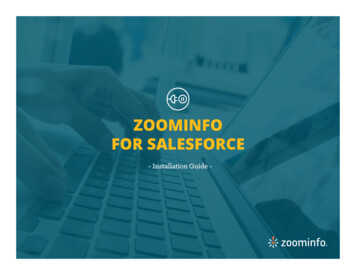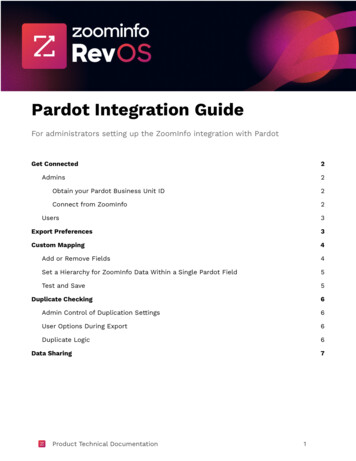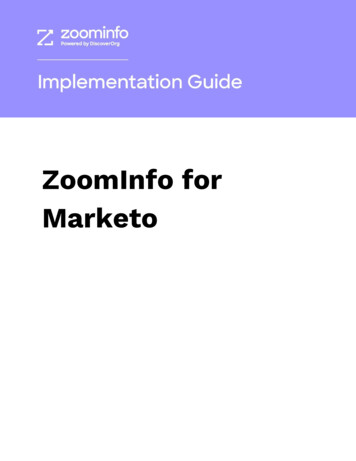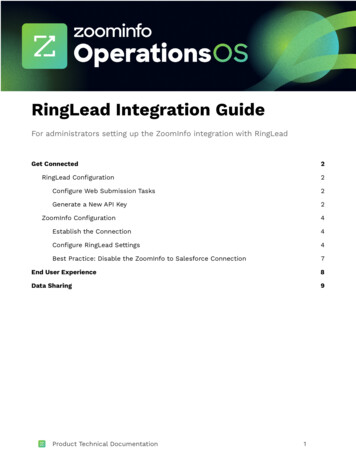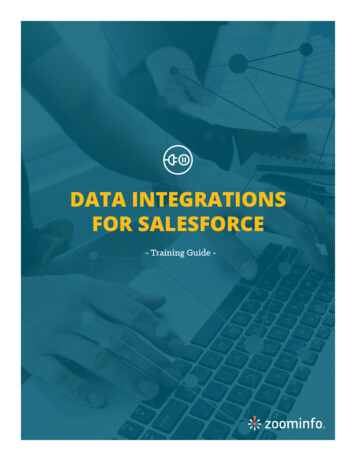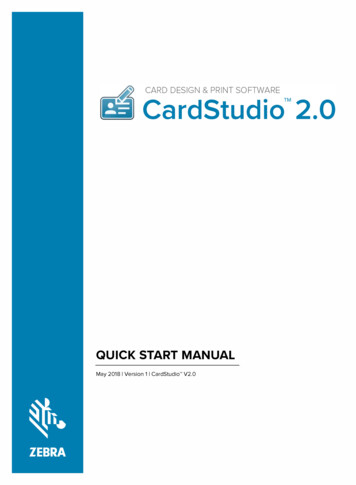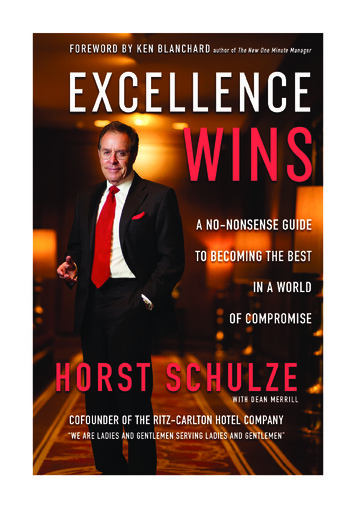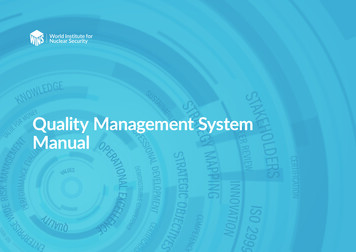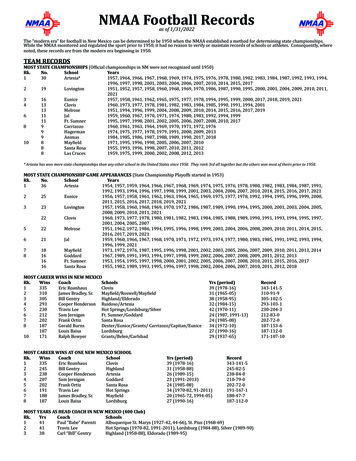
Transcription
10 Quick WinsFor Sales & MarketingA look at the best practicesleading companies are employingto improve conversion ratesat each phase of the funnel.In partnership with:
Table of Contents10 Quick WinsHow to improve conversion rates at each phase of the funnel. . . . . . . . . . . . 3A look at the best practicesleading companies are employingto improve conversion rates ateach phase of the funnel.Improve marketing results through pinpoint prospecting . . . . . . . . . . . . . . . . 4Refine lists and messaging: broader is not better. . . . . . . . . . . . . . . . . . . . . . . . 5for Sales & MarketingConvert inquiries to leads through nurture . . . . . . . . . . . . . . . . . . . . . . . . . . . . . 6Improve response rates through analysis and segmentation . . . . . . . . . . . . . . 7Increase the relevancy of your marketing content. . . . . . . . . . . . . . . . . . . . . . . 8Build a repeatable sales process . . . . . . . . . . . . . . . . . . . . . . . . . . . . . . . . . . . . . . . 9Leverage trigger events to shorten the sales cycle. . . . . . . . . . . . . . . . . . . . . . 10Use lead scoring and routing to increase close rates . . . . . . . . . . . . . . . . . . . . 11Find like-minded buyers. . . . . . . . . . . . . . . . . . . . . . . . . . . . . . . . . . . . . . . . . . . . . 12Get sales and marketing on the same page. . . . . . . . . . . . . . . . . . . . . . . . . . . . 13In partnership with:10 QUICK WINS FOR SALES & MARKETING2
How to improve conversion rates at each phase of the funnelWhen the economy was still in a growth mode, it was easyfor B2B marketers to keep paying for more new leads to feedthe funnel. Now, as efficiency has become the rule of the day,companies realize they can’t afford to let valid contacts wasteaway in their database. They have to get smarter about howthey find and follow-up on leads.As a result, more and more companies are putting a newemphasis on nurturing the leads they have and finding moreeffective ways to convert leads through the various stages ofthe marketing and sales funnel.In this e-book, we examine ten ways sales organizations canaccelerate the progression from cold to close. From improvingmarketing results through pinpoint prospecting to makingsure sales and marketing are on the same page, here are sometangible steps you can take to move faster from cold to close.Sales / Marketing FunnelCampaign ResourcesNurturingQualified LeadsNurturingLeads PrioritizedFor SalesNurturingActiveOpportunityClosedBusinessIn partnership with:10 QUICK WINS FOR SALES & MARKETING3
1. Improve marketing results through pinpoint prospecting“Pinpoint prospecting” means taking the time to identifyand locate the right markets, companies, and titles. Marketintelligence and advisory firm IDC also categorizes thisfocused approach under sales enablement, and defines it as“the delivery of the right information to the right personat the right time in the right format and in the right place toassist in moving a specific sales opportunity forward.”was able to determine the upcoming IT initiatives of over3,000 companies, and then target those companies with acustomized message based on those upcoming initiatives. Byusing this approach, the company increased the conversionrate of initial meetings turning into pipeline from 55% to 81%.IDC views sales enablement as so important that it says“developing and implementing a focused sales enablementstrategy, which allows reps to have qualitatively different andrelevant conversations, will have the greatest positive impacton revenue this year.”Pinpoint prospecting strategies can vary by industry, companysize and competitive positioning. Some B2B organizationshave had success by pulling key qualifying data, segmented byindustry, title or potential technology requirements. Advancedorganizations have taken this a step further by drilling downto companies that run a certain type of hardware or belong tolarge charitable groups.One reason IDC is so big on sales enablement—or pinpointprospecting—is that it works. Case in point: a major antivirussoftware company was able to pinpoint prospects thathad competitors’ contracts expiring in the next year. Theywere able to segment that market by competitor, andthe prospect’s satisfaction with that vendor. They thenallocated more time and resources to the prospects with lowsatisfaction, and were able to displace key accounts from theircompetitors systematically.Another example of the power of pinpoint prospecting:one of the largest technology companies in the worldIn partnership with:The TakeawayPinpoint prospecting is really about knowing precisely whoyour ideal customer is and what matters to them. Thefurther you drill down, the more targeted and relevant yourconversation becomes. Whereas old school prospecting mighthave meant pulling a list of IT managers, pinpoint prospectingmeans pulling a list of IT managers who work in supply chainmanagement at companies with annual revenues in excess of 50M. Narrow it down to just the IT managers that golf andyou’ve got yourself a pinpoint prospect.10 QUICK WINS FOR SALES & MARKETING4
2. Refine lists and messaging: broader is not betterSavvy marketers are improving results by carefully identifyingprospects and then gearing marketing efforts to them. It’spinpoint prospecting applied to lists and messaging.“Many marketers, reluctant to miss any avenue of opportunity,define their target as broadly as possible and in so doingmiss the chance to convincingly address the most potentprospects,” says Dan McDade, president of PointClear, a B2Bprospecting consultancy. “A typical example is a company thatperceives its target market to be the Fortune 500, when themost likely purchasers are actually a much smaller audiencewithin that group. Those companies that are quicker to seethe value proposition of a product, whether due to immediatebusiness pains or because they are looking to enhance theirown capabilities, are readier to respond at higher levels thanothers, so it makes sense to identify those segments andmarket to them specifically.”This approach is validated by a study showing thatthe deliverability of email improves dramatically withsegmentation. According to the study by analyst firmAberdeen Group, email marketers that pay careful attentionto customer behavior and segmentation achieve an averageemail delivery rate of 90.2%, well above the 82.3% average.The study, which was summarized in a report entitled“Demystifying Email Deliverability,” found that “best-in-class”email marketers are 30% more likely to tie email deliverabilityIn partnership with:to customer retention than “laggards,” who focus more onrevenue generation. “‘Best-in-class’ marketers build lastingrelationships with opt-in recipients of email marketingcampaigns [encouraging them] to focus on maintainingquality email lists containing recipients who want tocommunicate via email marketing,” the study reports. Bettersales performance is a result, Aberdeen concluded.PointClear’s McDade notes that refining lists and messaginghas an additional benefit. “By applying market intelligenceand finely defined segmentation strategies, we have beensuccessful in increasing sales performance while actuallyreducing marketing costs,” he says.IDC has reached the same conclusion, stating that“investments in sales enablement will have immediate ROI,both from reduced marketing and sales costs, and increasedsales productivity. They should pay for themselves.The TakeawayToo often, B2B marketers are tempted to follow consumermarketers by casting their net as wide as possible. This notonly leads to inefficient marketing spend, but also wasted timefrom the sales team chasing unqualified leads. Industry leadersare driving higher conversion rates by going narrower anddeeper into high profit potential prospects. By knowing theright contacts and pain points within those target accounts,the engagement process accelerates and close rates improve.10 QUICK WINS FOR SALES & MARKETING5
3. Convert inquiries to leads through nurtureAfter driving inquiries into the top of the funnel, the nextkey phase is converting inquiries into qualified leads. A recentsurvey conducted by Silverpop, a provider of email marketingand marketing automated solutions, confirms that B2Bmarketers will be focusing more on the lead-to-sales funnelover the next 12 months, especially on the conversion of leadsto opportunities. Based on responses from 446 marketers,the Silverpop study found nearly one quarter (24%) said“ensuring qualified leads are converting into appropriate salesopportunities” was their top priority.As any sales organization knows, this kind of qualificationcannot be automated; it must come from a human, usually inthe form of an inside sales or teleprospecting team. “Lots ofcompanies use email, web links, and registration for content togenerate demand and nurture leads,” says Dave Green, CEO ofPipeAlign, a company that provides lead generation and leadmanagement services. “The problem is that most companiesuse such campaigns once. They engage in a monologueinstead of a learning exchange. But what about a continuouslyrunning automated ‘dialogue’ with customers and prospects?”That’s what Green calls Digital Dialogue, an emerging andpowerful new approach to lead nurturing.According to Green, Digital Dialogue engages customers andprospects in a scalable, low-cost, automated informationexchange, primarily over the Internet. Companies that sellcomplex solutions can use that exchange to educate andqualify potential business buyers before those buyers talkIn partnership with:to a live representative. This education and qualificationprocess can last for months across numerous, interconnectedexchanges. “Digital Dialogue is necessary for inquiry nurturingbecause most prospects don’t want to talk to sales peopleearly in an investigation of a complex product or service,”explains Green.Industry research firm Aberdeen Group says it’s important forevery sales organization to use some kind of “lead nurturing”system, whether it’s Digital Dialogue or a system developed onits own.The TakeawayThe industry benchmark for moving a response to a leadqualified by marketing is typically between 4% and 10%. Evensmall improvements in conversion rates at this phase of thefunnel can have a big impact on deal close rates and top linerevenue for any business. In addition, some companies aredrilling down into leads which have previously disqualifiedand finding new opportunities through a new contact or newmessaging.“Digital Dialogue is necessary for inquiry nurturing becausemost prospects don’t want to talk to sales people early inan investigation of a complex product or service.”Dave Green,CEO of PipeAlign10 QUICK WINS FOR SALES & MARKETING6
4. Improve response rates through analysis and segmentationMany high-growth organizations have shown dramaticimprovement in their campaign inquiry rate by applyingadvanced marketing techniques—such as segmentation,personalization, A/B testing, multichannel campaigns, andevent-triggered automation-to their lead generation efforts.The simple fact is the more targeted a sales organizationis with its audience and message, the better the results.One company shortened its sales cycle by 85% by aligningsales and marketing to deliver a highly-relevant message. Itstarted by reviewing its current client base and identifyingthe industries where it is most strongly differentiated. Thecompany focused its first campaign on the IT industry,segmenting further using specific job titles within thatindustry. On week one, a two-email campaign was sent to4,934 people. By the end of week three, the company hadclosed two deals-one of which surpassed its average deal sizeand accelerated its sales cycle by 77%.Pleased with the success of this initial effort, the companydecided to take an even more targeted approach and decidedto focus on a specific IT industry niche audience: networksecurity. It pulled a list of 1,100 prospects for this highlytargeted audience and prepared a one-week blitz, comprisingtwo emails and telephone follow-up by its sales team. Theresults were even stronger than the first campaign. Despitetargeting less than one-fourth the number of people as its firstIn partnership with:campaign, the company closed four deals within two weeks,an 85% reduction of its standard sales cycle.This example shows how segmenting their audience anddelivering highly relevant messages to those audiences canenable sales organizations to enjoy stronger ROI and morerobust sales.The TakeawayBy using highly targeted information about prospects andleads to slice and dice the demographics, large and small B2Bcompanies have been able to deliver relevant messages totargeted buyers. This not only drives ROI in terms of closeddeal, but makes the marketing spend more efficient due tofewer bounce-backs and better response rates.The more time you invest up front identifying your target andbuttoning down your message the more efficient your salesprocess becomes and the better your ROI. B2B companieswho know how to segment properly will enjoy betterresponse rates because they’re reaching the right people.Despite targeting less than one-fourth the numberof people as its first campaign, the company closedfour deals within two weeks, an 85% reduction of itsstandard sales cycle.10 QUICK WINS FOR SALES & MARKETING7
5. Increase the relevancy of your marketing contentJoe Pulizzi, a leading author, speaker, marketer, and strategistfor content marketing, suggests three ways companies canperform an inventory of the content they send to customersand prospects. “This is the type of information you distributethat educates your customers and positions you as an expertresource,” he says.Listen to your customers. Use simple tools like Google Alertsand Twitter Search to figure out what your customers andprospects are struggling with. Target important keywordphrases and follow the conversation. Topics should appearthat show trends and the need to expand on key issues. Ifthat’s not enough, ask them. Call them up and talk to them.Visit them in person. Use online survey tools. Your customerswant to share this information because they, in most cases,want to solve their challenges. If you can help, that’s great forthem.Review those doing it right. In most cases, especially in B2Bmarkets, trade publications have served this need for years.What are the issues they are focusing on? What are they notfocusing on that they should? You can be the resource thatIn partnership with:takes this content to the next level. Good enough is not goodenough anymore. Your content needs to be the best. Find outwhat it will take to get there.Recruit help. Even if you have the best experts in the industry,most times you need outside journalistic help to tell yourstory in a way that positions your information as necessary toyour customers’ career survival. Partner with an individual oran organization that will help you develop a content factorywithin your organization. Those organizations will help youthink and act more like a publisher.The TakeawayKnowing the pain points of your top prospects increases thelikelihood that you will deliver relevant messaging, whether itis via an email, voice mail or direct mail campaign. Experiencedsales and marketing teams are using insights from publishedmaterial and speaking engagements to learn more about thehot button topics for hard-to-reach C-level executives.10 QUICK WINS FOR SALES & MARKETING8
6. Build a repeatable sales processJoe Galvin, vice president and service director at SiriusDecisions, a benchmark and advisory firm that providescomparative analysis, metrics, advice, and tools to improvesales and marketing effectiveness, explains that a repeatablesales process is fundamental to everything else a salesorganization does. “The reality is, if you don’t have a strong,repeatable process, the money that is spent on salesautomation is wasted,” says Galvin.organization. “Look at the processes that your most successfulreps use and repeat them,” he advises.“Einstein noted that doing the same thing over and over againand expecting a different result is insanity,” says Galvin. “Butdoing the same effective thing over and over again is geniusbecause it saves steps and repeats successful techniques.” Theresult: shorter sales cycles, higher win rates, and larger dealsizes.He adds that it’s essential for sales organizations to establishsales process milestones. “For example, when leads are passedfrom marketing to sales, that status must be clearly known,”he says. “Once sales goes through the process of acceptingthe leads, they are committing to following up on them. Bycreating repeatable, reliable processes such as this, everyoneknows what to expect and both efficiencies and effectivenessincrease throughout the organization.”The TakeawayGavin says there must also be internal agreement todefinitions and a mutually accepted process for assessingopportunities. A repeatable sales process also meansexamining and replicating “everything that works” within theAccording to CSO Insights, nearly 60% of all reps fail toachieve their goals. In order to get more of the “B” sales repsperforming like “A” players, many leading organizations areproviding newer reps with smart prospecting tools that helpidentify and influence the right gatekeepers who can help getdeals closed.“The reality is, if you don’t have a strong, repeatableprocess, the money that is spent on sales automationis wasted.”Joe Galvin,VP of Sirius DecisionsIn partnership with:10 QUICK WINS FOR SALES & MARKETING9
7. Leverage trigger events to shorten the sales cycleIn today’s economic environment, shortening sales cycleshas taken on a new importance. After all, the shorter thesales cycle, the more sales an organization can make-and thefaster revenues can start coming in. But, according to SiriusDecisions, the sales cycle has become 22% longer as buyers aretaking longer to consider their decisions.“There’s no getting around it,” says Jill Konrath in her Selling toBig Companies blog (http://sellingtobigcompanies. blogs.com).“Corporate buyers are involving more people in the decisionand it takes forever to get them all together. Urgent fires andpressing priorities pop up, further delaying or derailing yoursales efforts. It can be so darn frustrating because you have nocontrol over these situations.”The solution? Konrath advises sellers to leverage triggerevents to drive short-term sales results. What is a triggerevent? “It’s an ‘occurrence’ that creates an immediate needfor your products or services. Internal trigger events includereorganizations, mergers, acquisitions or new productintroductions. External triggering events could be newlegislation, hurricanes or announcements of new technology.”In partnership with:Jim Lenskold, president of the Lenskold Group, a leader inthe development and implementation of marketing ROIprocesses, points out that “with a detailed ROI calculation thatincludes the cost of sales resources, your marketing effortsto shorten the sales cycle can be quantified in the reducedcost of sales time. Shorter sales cycles also tend to increaseconversion rates.” He adds that it is generally more profitableto increase conversion of existing leads than to generate moreleads. “Think of this as a continuation of your lead generationeffectiveness instead of a separate effort,” says Lenskold.The TakeawayBeing “first in” can be invaluable to winning a deal. Byresponding to trigger events such as changes in management,a merger or a new product launch, leading B2B players aregaining “favored vendor” status and are not only edging outtheir competition, but they are also positioning themselves forfuture cross-sells.10 QUICK WINS FOR SALES & MARKETING10
8. Use lead scoring and routing to increase close ratesSales close rates can be affected by a number of factors—many of which cannot be influenced by marketing. Butthat doesn’t mean that marketing cannot increase saleseffectiveness. Gartner Group Research found that “followingimprovements in lead, content and proposal management,close rates could be expected to increase, on average, byapproximately 5% to 20% per salesperson.”The most dramatic example of the economics of the salesand marketing funnel comes when you look at the close ratesof different organizations. The average close rate for B2Borganizations is less than 25%, according to Sirius Decisions.One way to increase close rates is to find contacts anddecision makers who can be “champions” within targetcompanies. These referral sources are invaluable when itcomes to making a business case for a sale.According to Aberdeen, companies with best-in-classlead prioritization and scoring systems have a 192% higheraverage lead qualification rate than those that do not. It’s notsurprising, then, that Sirius Decisions found that 52% of B2Bcompanies with sales over 100 million already have somekind of lead scoring system in place, with another 26% indevelopment. Case studies have consistently shown that theIn partnership with:use of lead scoring has driven improved conversion rates, winrates, increased average revenue per deal, and shortened salescycles.Lead scoring and lead routing systems can also help to boostyour close rates by helping to identify qualified leads. Thisapproach helped EDGAR Online, a leader in global financialreporting, see a 400% increase in leads generated. Afterimplementing lead scoring and routing, the company is nowable to identify 5 times as many qualified leads each monththan it did before. The quality of those leads has resulted in aclose rate more than double the industry average.The TakeawayMany B2B sales and marketing teams struggle with aknowledge gap in terms of where their prospects are withbudgets and consideration timelines. Lead scoring has helpedcompanies deploy their best sales people to focus on thehighest value opportunities. Once accounts are prioritized,further research has provided these teams with insights intothat prospect’s pain points as well as additional influencerswithin that company.According to Aberdeen Group, companies with bestin-class lead prioritization and scoring systems have a192% higher average lead qualification rate than thosethat do not.10 QUICK WINS FOR SALES & MARKETING11
9. Find like-minded buyersEvery good customer can lead to other good prospects. SiriusDecision’s Joe Galvin sums up the power of reference selling:“If I have sold inside an organization to a given buying center,I can use them to refer me to someone else,” he says. Galvinadvises sales organizations to build “profiles of success”-adescription of needs, criteria, roles, and responsibilities basedon previous sales success and using these profiles to identifylike-minded buyers.based on the demographics of its readers or viewers. “TheMasters Tournament reaches a different audience than aNASCAR race,” Galvin points out. “And you can apply the sameprinciples that work for B2C marketing to B2B selling. Get asmuch information as you can about the people you want tosell to before you contact them. Once you have success withone individual, use information about his or her roles andresponsibilities to target other similar prospects.”“If you’ve sold well into a certain part of an organization, thenyou know that they are more likely to buy than someone in aslower growth industry, or a less progressive company.”The TakeawayGalvin also suggests identifying the traits of both thecompany and individual being sold to in order to locateprospects that are more likely to find value in what you offer.“Data lists focused on individuals are invaluable in helpinginside sales reps search for and find people with certain titlesand roles,” he says.This kind of targeted marketing is a one-to-one version ofwhat marketers do on a large scale when selecting mediaIn refining their contact databases and cleaning up theirpipeline, B2B organizations large and small often start byidentifying target companies and decision makers. By diggingdeeper into their latest announcements and researchingkey industry events they attend, sales and marketing teamsare able to identify common connections between theirneeds. Some companies are even developing personabased marketing, which develops specifics strategies aroundcommon profiles.“Get as much information as you can about the peopleyou want to sell to before you contact them. Onceyou have success with one individual, use informationabout his or her roles and responsibilities to targetother similar prospects.”Joe Galvin,VP of Sirius DecisionsIn partnership with:10 QUICK WINS FOR SALES & MARKETING12
10. Get sales and marketing on the same pageThe 2008 Miller Heiman Sales Best Practices Study found thatonly 37% of respondents agreed that their sales and marketingorganizations were aligned in what their customers want andneed.Aberdeen Group analyst Ian Michiels offers eight essentialsteps every organization can take, today, to start aligning salesand marketing:Marketing Needs to Take Accountability for Influencing theBuying Cycle. I believe marketers should take full ownershipof the buying cycle. Marketing material and campaigns shouldbe structured to address each phase in the buying cycle andhelp educate and influence prospects.Increase Quality and Decrease Quantity by Scoring Leads. Inessence, organizations should be focusing on the quality, notthe quantity of leads that are passed from marketing to sales.Start Using “We” Stop Using “They.” Alignment starts with acompany wide commitment that together we stand, dividedwe fall.Integrate Sales and Marketing Technologies. Byintegrating CRM and marketing technology, reps can gain acomprehensive view of how marketing interacted with anaccount. The goal is to deliver value to reps in the vehicleStandardize Definitions. Eighty-six percent (86%) of marketing they are most accustomed to using on a daily basis; CRM. Fordepartments in superior performing organizations qualifythis reason, integration is critical to empowering sales andleads before passing them to sales. Likewise, 73% of thesemarketing with data that both functions can use to increasesuperior performing organizations share the definition of aeffectiveness.qualified lead between sales and marketing; versus 38% of allothers.In partnership with:10 QUICK WINS FOR SALES & MARKETING13
Set Up Periodic Meetings Between Sales and Marketing.Sales and Marketing should be meeting on a periodic basisto review successes and failures. Alignment means bothfunctions are working as a team, so if processes or practicesare not yielding expected results, something needs tochange. Seventy-three percent (73%) of superior performingorganizations sales and marketing departments meetperiodically to review performance.Measure What Matters. Measurement is probably oneof the most important components to aligning sales andmarketing effectiveness. How can you improve if you don’tknow where you’ve been and how do you know whereyou’ve been if you don’t have measurement? Metrics allowthe organization to understand how much to spend onmarketing to acquire a new customer and more importantlywhere to spend those dollars to acquire, retain, and up-sellto prospects and customers.Allow Sales to Pass Leads Back to Marketing. If sales andmarketing are aligned, then there needs to be a way to passleads seamlessly between both functions. Sales need to beable to pass leads back to marketing for further nurturing ifan opportunity in the pipeline suddenly goes cold. Marketingneeds to develop separate lead nurturing programs to addressthe unique needs of pre-qualified leads that are not yet readyto purchase. These are real revenue opportunities that all toooften fail to be harvested by organizations.The TakeawayWith deals taking longer to close and more executivesinfluencing the buying cycle, marketing is playing a larger rolein gathering intelligence into the changing needs inside targetorganizations. Companies that align marketing and sales earlyin the process are able to quickly identify key decision makers,nurture them with the right messaging and then acceleratethem through the different phases of the sales funnel.“The goal is to deliver value to reps in the vehicle theyare most accustomed to using on a daily basis; CRM.For this reason, integration is critical to empoweringsales and marketing with data that both functions canuse to increase effectiveness.”Ian Michiels,Aberdeen GroupIn partnership with:10 QUICK WINS FOR SALES & MARKETING14
This DemandGen Report issponsored by ZoomInfoAbout ZoomInfoZoomInfo is the leading B2B directory and business information providerthat offers real-time, in-depth profiles of millions of businesses andemployees and the market’s most powerful tools for searching andtargeting. Its products help businesses efficiently connect with each otherto accelerate their growth. For more information, go towww.zoominfo.com or call 866-904-9666.307 Waverley Oaks RoadWaltham, MA 02452 USAwww.zoominfo.com866.904.ZOOM (9666)
survey conducted by Silverpop, a provider of email marketing and marketing automated solutions, confirms that B2B marketers will be focusing more on the lead-to-sales funnel over the next 12 months, especially on the conversion of leads to opportunities. Based on responses from 446 marketers, the Silverpop study found nearly one quarter (24%) said
